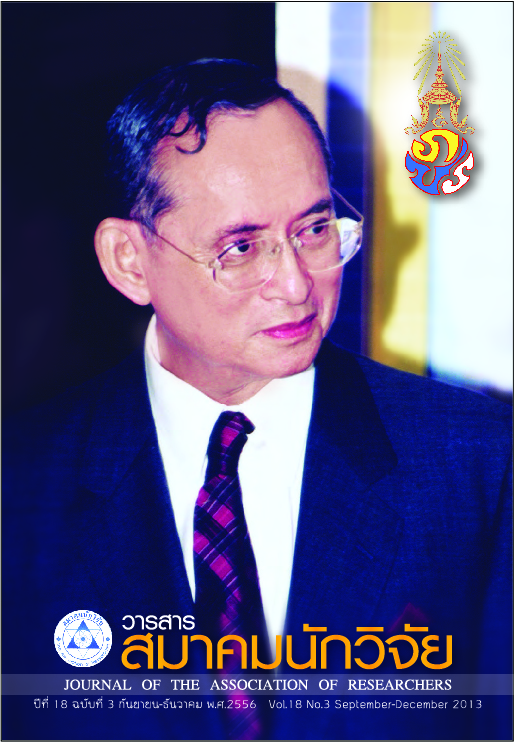The Structural Relationship Model Development of Adminitrators’ Competencies toward School Effectiveness
Main Article Content
Abstract
The objectives of this study were to develop, to test and to present the Structural Model
Development of Administrators’ Competencies toward School Effectiveness (ACSE). Sixty-hundred
subjects of this study were drawn, with the multi-stage random sampling, from both school administrators
and teachers at the primary schools under Offiffiices of Primary Education Service in Sakon Nakhon
provincial areas, in the academic year 2011. The following Statistics were applied: frequency, percentage,
mean, standard deviation, Pearson’s product-moment correlation coeffififfiicient , and path analysis. Research
results were as follows: 1) Structural relationship model of the ACSE consisted of 5 components,
namely background of school administrators, situation concerning with school administrators, competencies
of school administrators, and school effectiveness; 2) As a result of model testing, it revealed
the empirical data related with the model and statistical assumptions, and those statistical values as
Chi-square = 348.74, p-value = 0.21, df =195, RMSEA= 0.03; and 3) For the structural relationship
model of the ACSE, it could be concluded as follows: School effectiveness with the administrator
competencies got the positive direct effects from crucial categories: school administrator competencies
(Direct Effect or DE=0.97), Situation concerning with school administrators (DE=0.82), and competencies
of background and situation concerning with school administrators through category of administrator
competencies. Those categories could explained the variance of school effectiveness at the 81 percent,
and at the .05 level of signififfiicance.
Article Details
บทความที่ปรากฏในวารสารนี้ เป็นความรับผิดชอบของผู้เขียน ซึ่งสมาคมนักวิจัยไม่จำเป็นต้องเห็นด้วยเสมอไป การนำเสนอผลงานวิจัยและบทความในวารสารนี้ไปเผยแพร่สามารถกระทำได้ โดยระบุแหล่งอ้างอิงจาก "วารสารสมาคมนักวิจัย"
References
นงลักษณ์ วิรัชชัย. (2542).โมเดลลิสเรล สถิติวิเคราะห์สำหรับการวิจัย.พิมพ์ครั้งที่ 3. กรุงเทพมหานคร :โรงพิมพ์จุฬาลงกรณ์มหาวิทยาลัย.
บุญชม ศรีสะอาด. (2545). การวิจัยเบื้องต้น. พิมพ์ครั้งที่ 2. กรุงเทพมหานคร : สุวีวิริยาสาส์น.
เรชา ชูสุวรรณ. (2550). รูปแบบความสัมพันธ์เชิงสาเหตุของสมรรถนะบุคคลที่ส่งผลต่อประสิทธิผลของ สำนักงานเขตพื้นที่การศึกษา ในสามจังหวัดชายแดนภาคใต้. วิทยานิพนธ์ศึกษาศาสตรดุษฎีบัณฑิตสาขาวิชาการบริหารการศึกษา มหาวิทยาลัยสงขลานครินทร์.
วาโร เพ็งสวัสดิ์. (2549). การพัฒนารูปแบบความสัมพันธ์โครงสร้างเชิงเส้นตรงของประสิทธิผลภาวะผู้นำของผู้บริหารที่ส่งผลต่อประสิทธิผลของโรงเรียน. วิทยานิพนธ์ศึกษาศาสตรดุษฎีบัณฑิตสาขาวิชาการบริหารการศึกษา บัณฑิตวิทยาลัย มหาวิทยาลัยขอนแก่น.
วิทยา จันทร์ศิริ. (2551). การพัฒนาสมรรถนะหลักของผู้บริหารสายสนับสนุนในมหาวิทยาลัยของรัฐ.วิทยานิพนธ์การศึกษาดุษฎีบัณฑิต สาขาวิชาการบริหารและพัฒนาการศึกษา บัณฑิตวิทยาลัยมหาวิทยาลัยมหาสารคาม.
ศักดิ์ไทย สุรกิจบวร. (2549). รายงานการวิจัยเรื่องการวิเคราะห์งานวิจัยทางการบริหารการศึกษา.สกลนคร: คณะครุศาสตร์ มหาวิทยาลัยราชภัฏสกลนคร.
สุกัญญา รัศมีธรรมโชติ. (2549). แนวทางการพัฒนาศักยภาพมนุษย์ด้วย Competency based learning.พิมพ์ครั้งที่ 3. กรุงเทพมหานคร: ศิริวัฒนาอินเตอร์พริ้นท์.
สำนักงานคณะกรรมการข้าราชการพลเรือน. (2548). ความรู้ความสามารถ ทักษะ และสมรรถนะที่จำเป็นสำหรับตำแหน่ง. กรุงเทพมหานคร : พี.เอ.ลีฟวิ่ง.
สำนักงานคณะกรรมการศึกษาขั้นพื้นฐาน. (2552). การพัฒนาคุณภาพการศึกษาของสำนักงานคณะกรรมการการศึกษาขั้นพื้นฐาน. กรุงเทพมหานคร :โรงพิมพ์คุรุสภา.
สำนักงานเลขาธิการสภาการศึกษา. (2552). สรุปผลการดำเนินงาน 9 ปี ของการปฏิรูปการศึกษา.กรุงเทพมหานคร : พริกหวานกราฟฟิค.
McCleland, D. (1973). “Testing for competence rather than for intelligence.” American Psychologist, 28(1), 1-14.


